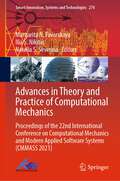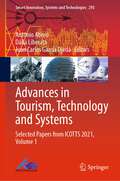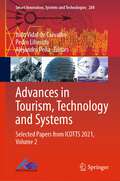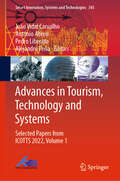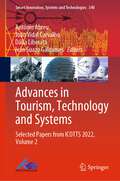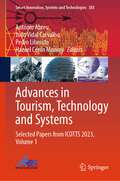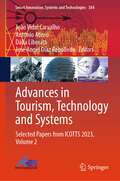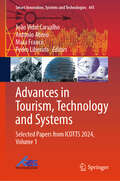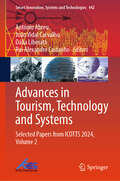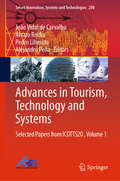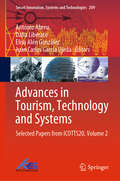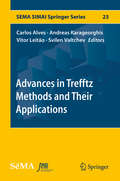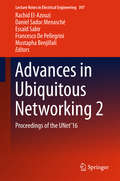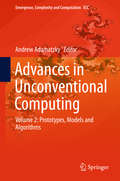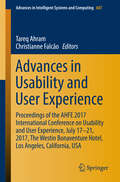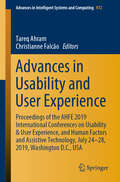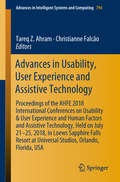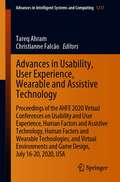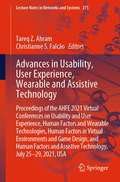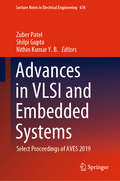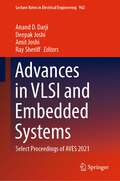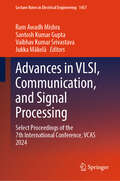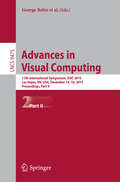- Table View
- List View
Advances in Theory and Practice of Computational Mechanics: Proceedings of the 22nd International Conference on Computational Mechanics and Modern Applied Software Systems (CMMASS 2021) (Smart Innovation, Systems and Technologies #274)
by Margarita N. Favorskaya Ilia S. Nikitin Natalia S. SeverinaThis book is a collection of peer-reviewed best selected research papers presented at 22nd International Conference on Computational Mechanics and Modern Applied Software Systems (CMMASS 2021), held at the Alushta Health and Educational Center, The Republic of Crimea, during 4–13 September 2021. The proceedings is dedicated to solving the real-world problems of applied mechanics using smart computational technology. Physical and mathematical models, numerical methods, computational algorithms and software complexes are discussed, which allow to carry out high-precision mathematical modelling in fluid, gas and plasma mechanics, in general mechanics, deformable solid mechanics, in strength, destruction and safety of structures, etc. Smart technologies and software systems that provide effective solutions to the problems at various multi scale-levels are considered. Special attention is paid to the training of highly qualified specialists for the aviation and space industry.
Advances in Tourism, Technology and Systems: Selected Papers from ICOTTS 2021, Volume 1 (Smart Innovation, Systems and Technologies #293)
by António Abreu Dália Liberato Juan Carlos Garcia OjedaThis book features a collection of high-quality research papers presented at the International Conference on Tourism, Technology & Systems (ICOTTS 2021), held at the University of Cartagena, in Cartagena de Indias, Colombia, from 4 to 6 November 2021. The book is divided into two volumes, and it covers the areas of technology in tourism and the tourist experience, generations and technology in tourism, digital marketing applied to tourism and travel, mobile technologies applied to sustainable tourism, information technologies in tourism, digital transformation of tourism business, e-tourism and tourism 2.0, big data and management for travel and tourism, geotagging and tourist mobility, smart destinations, robotics in tourism, and information systems and technologies.
Advances in Tourism, Technology and Systems: Selected Papers from ICOTTS 2021, Volume 2 (Smart Innovation, Systems and Technologies #284)
by Pedro Liberato João Vidal de Carvalho Alejandro PeñaThis book features a collection of high-quality research papers presented at the International Conference on Tourism, Technology & Systems (ICOTTS 2021), held at the University of Cartagena, in Cartagena de Indias, Colombia, from 4 to 6 November 2021. The book is divided into two volumes, and it covers the areas of technology in tourism and the tourist experience, generations and technology in tourism, digital marketing applied to tourism and travel, mobile technologies applied to sustainable tourism, information technologies in tourism, digital transformation of tourism business, e-tourism and tourism 2.0, big data and management for travel and tourism, geotagging and tourist mobility, smart destinations, robotics in tourism, and information systems and technologies.
Advances in Tourism, Technology and Systems: Selected Papers from ICOTTS 2022, Volume 1 (Smart Innovation, Systems and Technologies #345)
by António Abreu Pedro Liberato Alejandro Peña João Vidal CarvalhoThis book features a collection of high-quality research papers presented at the International Conference on Tourism, Technology and Systems (ICOTTS 2022), held at University of Chile, Santiago de Chile, Chile, from 3 to 5 November 2022. The book is divided into two volumes, and it covers the areas of technology in tourism and the tourist experience, generations and technology in tourism, digital marketing applied to tourism and travel, mobile technologies applied to sustainable tourism, information technologies in tourism, digital transformation of tourism business, e-tourism and tourism 2.0, big data and management for travel and tourism, geotagging and tourist mobility, smart destinations, robotics in tourism, and information systems and technologies.
Advances in Tourism, Technology and Systems: Selected Papers from ICOTTS 2022, Volume 2 (Smart Innovation, Systems and Technologies #340)
by António Abreu Dália Liberato João Vidal Carvalho Iván Suazo GaldamesThis book features a collection of high-quality research papers presented at the International Conference on Tourism, Technology and Systems (ICOTTS 2022), held at University of Chile, Santiago de Chile, Chile, from 3 to 5 November 2022. The book is divided into two volumes, and it covers the areas of technology in tourism and the tourist experience, generations and technology in tourism, digital marketing applied to tourism and travel, mobile technologies applied to sustainable tourism, information technologies in tourism, digital transformation of tourism business, e-tourism and tourism 2.0, big data and management for travel and tourism, geotagging and tourist mobility, smart destinations, robotics in tourism, and information systems and technologies.
Advances in Tourism, Technology and Systems: Selected Papers from ICOTTS 2023, Volume 1 (Smart Innovation, Systems and Technologies #383)
by António Abreu Pedro Liberato João Vidal Carvalho Hazael Cerón MonroyThis book features a collection of high-quality research papers presented at the International Conference on Tourism, Technology and Systems (ICOTTS 2023), held at Anáhuac University, Bacalar, Mexico, from 2 to 4 November 2023. The book is divided into two volumes, and it covers the areas of technology in tourism and the tourist experience, generations and technology in tourism, digital marketing applied to tourism and travel, mobile technologies applied to sustainable tourism, information technologies in tourism, digital transformation of tourism business, e-tourism and tourism 2.0, big data and management for travel and tourism, geotagging and tourist mobility, smart destinations, robotics in tourism, and information systems and technologies.
Advances in Tourism, Technology and Systems: Selected Papers from ICOTTS 2023, Volume 2 (Smart Innovation, Systems and Technologies #384)
by António Abreu Dália Liberato João Vidal Carvalho José Angel Díaz RebolledoThis book features a collection of high-quality research papers presented at the International Conference on Tourism, Technology and Systems (ICOTTS 2023), held at Anáhuac University, Bacalar, Mexico, from 2 to 4 November 2023. The book is divided into two volumes, and it covers the areas of technology in tourism and the tourist experience, generations and technology in tourism, digital marketing applied to tourism and travel, mobile technologies applied to sustainable tourism, information technologies in tourism, digital transformation of tourism business, e-tourism and tourism 2.0, big data and management for travel and tourism, geotagging and tourist mobility, smart destinations, robotics in tourism, and information systems and technologies.
Advances in Tourism, Technology and Systems: Selected Papers from ICOTTS 2024, Volume 1 (Smart Innovation, Systems and Technologies #441)
by António Abreu Pedro Liberato João Vidal Carvalho Mara FrancoThis book features a collection of high-quality research papers presented at the International Conference on Tourism, Technology and Systems (ICOTTS 2024), held at held at University of Madeira, Portugal, from 30 to 31 October 2024. The book is divided into two volumes, and it covers the areas of technology in tourism and the tourist experience, generations and technology in tourism, digital marketing applied to tourism and travel, mobile technologies applied to sustainable tourism, information technologies in tourism, digital transformation of tourism business, e-tourism and tourism 2.0, big data and management for travel and tourism, geotagging and tourist mobility, smart destinations, robotics in tourism, and information systems and technologies.
Advances in Tourism, Technology and Systems: Selected Papers from ICOTTS 2024, Volume 2 (Smart Innovation, Systems and Technologies #442)
by António Abreu Dália Liberato João Vidal Carvalho Rui Alexandre CastanhoThis book features a collection of high-quality research papers presented at the International Conference on Tourism, Technology and Systems (ICOTTS 2024), held at held at University of Madeira, Portugal, from 30 to 31 October 2024. The book is divided into two volumes, and it covers the areas of technology in tourism and the tourist experience, generations and technology in tourism, digital marketing applied to tourism and travel, mobile technologies applied to sustainable tourism, information technologies in tourism, digital transformation of tourism business, e-tourism and tourism 2.0, big data and management for travel and tourism, geotagging and tourist mobility, smart destinations, robotics in tourism, and information systems and technologies.
Advances in Tourism, Technology and Systems: Selected Papers from ICOTTS20 , Volume 1 (Smart Innovation, Systems and Technologies #208)
by Álvaro Rocha Pedro Liberato João Vidal de Carvalho Alejandro PeñaThis book features a collection of high-quality research papers presented at the International Conference on Tourism, Technology & Systems (ICOTTS 2020), held at the University of Cartagena, in Cartagena de Indias, Colombia, from 29th to 31st October 2020. The book is divided into two volumes, and it covers the areas of technology in tourism and the tourist experience, generations and technology in tourism, digital marketing applied to tourism and travel, mobile technologies applied to sustainable tourism, information technologies in tourism, digital transformation of tourism business, e-tourism and tourism 2.0, big data and management for travel and tourism, geotagging and tourist mobility, smart destinations, robotics in tourism, and information systems and technologies.
Advances in Tourism, Technology and Systems: Selected Papers from ICOTTS20, Volume 2 (Smart Innovation, Systems and Technologies #209)
by António Abreu Dália Liberato Elisa Alén González Juan Carlos Garcia OjedaThis book features a collection of high-quality research papers presented at the International Conference on Tourism, Technology & Systems (ICOTTS 2020), held at the University of Cartagena, in Cartagena de Indias, Colombia, from 29th to 31st October 2020. The book is divided into two volumes, and it covers the areas of technology in tourism and the tourist experience, generations and technology in tourism, digital marketing applied to tourism and travel, mobile technologies applied to sustainable tourism, information technologies in tourism, digital transformation of tourism business, e-tourism and tourism 2.0, big data and management for travel and tourism, geotagging and tourist mobility, smart destinations, robotics in tourism, and information systems and technologies.
Advances in Trefftz Methods and Their Applications (SEMA SIMAI Springer Series #23)
by Carlos Alves Andreas Karageorghis Vitor Leitão Svilen ValtchevIn this book we gather recent mathematical developments and engineering applications of Trefftz methods, with particular emphasis on the Method of Fundamental Solutions (MFS). These are true meshless methods that have the advantage of avoiding the need to set up a mesh altogether, and therefore going beyond the reduction of the mesh to a boundary. These Trefftz methods have advantages in several engineering applications, for instance in inverse problems where the domain is unknown and some numerical methods would require a remeshing approach.Trefftz methods are also known to perform very well with regular domains and regular data in boundary value problems, achieving exponential convergence. On the other hand, they may also under certain conditions, exhibit instabilities and lead to ill-conditioned systems. This book is divided into ten chapters that illustrate recent advances in Trefftz methods and their application to engineering problems. The first eight chapters are devoted to the MFS and variants whereas the last two chapters are devoted to related meshless engineering applications. Part of these selected contributions were presented in the 9th International Conference on Trefftz Methods and 5th International Conference on the MFS, held in 2019, July 29-31, in Lisbon, Portugal.
Advances in Type-2 Fuzzy Sets and Systems: Theory and Applications (Studies in Fuzziness and Soft Computing #301)
by Jerry Mendel Alireza Sadeghian Hooman TahayoriThis book explores recent developments in the theoretical foundations and novel applications of general and interval type-2 fuzzy sets and systems, including: algebraic properties of type-2 fuzzy sets, geometric-based definition of type-2 fuzzy set operators, generalizations of the continuous KM algorithm, adaptiveness and novelty of interval type-2 fuzzy logic controllers, relations between conceptual spaces and type-2 fuzzy sets, type-2 fuzzy logic systems versus perceptual computers; modeling human perception of real world concepts with type-2 fuzzy sets, different methods for generating membership functions of interval and general type-2 fuzzy sets, and applications of interval type-2 fuzzy sets to control, machine tooling, image processing and diet. The applications demonstrate the appropriateness of using type-2 fuzzy sets and systems in real world problems that are characterized by different degrees of uncertainty.
Advances in Ubiquitous Networking 2: Proceedings of the UNet’16 (Lecture Notes in Electrical Engineering #397)
by Francesco De Pellegrini Rachid El-Azouzi Essaïd Sabir Mustapha Benjillali Daniel Sadoc MenaschéThis volume offers the proceedings of the 2nd UNet conference, held in Casablanca May 30 - June 1, 2016. It presents new trends and findings in hot topics related to ubiquitous computing/networking, covered in three tracks and three special sessions: Main Track 1: Context-Awareness and Autonomy Paradigms Track Main Track 2: Mobile Edge Networking and Virtualization Track Main Track 3: Enablers, Challenges and Applications Special Session 1: Smart Cities and Urban Informatics for Sustainable Development Special Session 2: Unmanned Aerial Vehicles From Theory to Applications Special Session 3: From Data to Knowledge: Big Data applications and solutions
Advances in Unconventional Computing: Volume 2: Prototypes, Models and Algorithms (Emergence, Complexity and Computation #23)
by Andrew AdamatzkyThe unconventional computing is a niche for interdisciplinary science, cross-bred of computer science, physics, mathematics, chemistry, electronic engineering, biology, material science and nanotechnology. The aims of this book are to uncover and exploit principles and mechanisms of information processing in and functional properties of physical, chemical and living systems to develop efficient algorithms, design optimal architectures and manufacture working prototypes of future and emergent computing devices. This first volume presents theoretical foundations of the future and emergent computing paradigms and architectures. The topics covered are computability, (non-)universality and complexity of computation; physics of computation, analog and quantum computing; reversible and asynchronous devices; cellular automata and other mathematical machines; P-systems and cellular computing; infinity and spatial computation; chemical and reservoir computing. The book is the encyclopedia, the first ever complete authoritative account, of the theoretical and experimental findings in the unconventional computing written by the world leaders in the field. All chapters are self-contains, no specialist background is required to appreciate ideas, findings, constructs and designs presented. This treatise in unconventional computing appeals to readers from all walks of life, from high-school pupils to university professors, from mathematicians, computers scientists and engineers to chemists and biologists.
Advances in Usability and User Experience: Proceedings of the AHFE 2017 International Conference on Usability and User Experience, July 17-21, 2017, The Westin Bonaventure Hotel, Los Angeles, California, USA (Advances in Intelligent Systems and Computing #607)
by Tareq Ahram Christianne FalcãoThis book focuses on emerging issues in usability, interface design, human computer interaction and user experience, with a special emphasis on the research aimed at understanding human-interaction and usability issues with products, services and systems for improved experience. It covers modeling as well as innovative design concepts, with a special emphasis to user-centered design, and design for special populations, particularly the elderly. Virtual reality, digital environments, heuristic evaluation and feedback of devices' interfaces (visual and haptic) are also among the topics covered in this book. Based on the AHFE 2017 Conference on Usability & User Experience, held on July 17-21, 2017, in Los Angeles, California, USA, the book describes new findings, research methods and user-centered evaluation approaches.
Advances in Usability and User Experience: Proceedings of the AHFE 2019 International Conferences on Usability & User Experience, and Human Factors and Assistive Technology, July 24-28, 2019, Washington D.C., USA (Advances in Intelligent Systems and Computing #972)
by Tareq Ahram Christianne FalcãoThis book focuses on emerging issues in usability, interface design, human–computer interaction, user experience and assistive technology. It highlights research aimed at understanding human interaction with products, services and systems, and focuses on finding effective approaches for improving user experience. It also discusses key issues in designing and providing assistive devices and services to individuals with disabilities or impairment, to assist mobility, communication, positioning, environmental control and daily living. The book covers modelling as well as innovative design concepts, with a special emphasis on user-centered design, and design for specific populations, particularly the elderly. Virtual reality, digital environments, heuristic evaluation and forms of device interface feedback of (e.g. visual and haptic) are also among the topics covered. Based on the both the AHFE 2019 Conference on Usability & User Experience and the AHFE 2019 Conference on Human Factors and Assistive Technology, held on July 24-28, 2019, Washington D.C., USA, this book reports on cutting-edge findings, research methods and user-centred evaluation approaches.
Advances in Usability, User Experience and Assistive Technology: Proceedings of the AHFE 2018 International Conferences on Usability & User Experience and Human Factors and Assistive Technology, Held on July 21–25, 2018, in Loews Sapphire Falls Resort at Universal Studios, Orlando, Florida, USA (Advances in Intelligent Systems and Computing #794)
by Christianne Falcão Tareq Z. AhramThis book focuses on emerging issues in usability, interface design, human–computer interaction, user experience and assistive technology. It highlights research aimed at understanding human interaction with products, services and systems, and focuses on finding effective approaches for improving user experience. It also discusses key issues in designing and providing assistive devices and services to individuals with disabilities or impairment, to assist mobility, communication, positioning, environmental control and daily living. The book covers modelling as well as innovative design concepts, with a special emphasis on user-centered design, and design for specific populations, particularly the elderly. Virtual reality, digital environments, heuristic evaluation and forms of device interface feedback of (e.g. visual and haptic) are also among the topics covered. Based on the AHFE 2018 Conference on Usability & User Experience and the AHFE 2018 Conference on Human Factors and Assistive Technology, held on July 21–25, 2018, in Orlando, Florida, USA, this book reports on cutting-edge findings, research methods and user-centred evaluation approaches.
Advances in Usability, User Experience, Wearable and Assistive Technology: Proceedings of the AHFE 2020 Virtual Conferences on Usability and User Experience, Human Factors and Assistive Technology, Human Factors and Wearable Technologies, and Virtual Environments and Game Design, July 16-20, 2020, USA (Advances in Intelligent Systems and Computing #1217)
by Tareq Ahram Christianne FalcãoThis book addresses emerging issues in usability, interface design, human–computer interaction, user experience and assistive technology. It highlights research aimed at understanding human interactions with products, services and systems and focuses on finding effective approaches for improving the user experience. It also discusses key issues in designing and providing assistive devices and services for individuals with disabilities or impairment, offering them support with mobility, communication, positioning, environmental control and daily living. The book covers modeling as well as innovative design concepts, with a special emphasis on user-centered design, and design for specific populations, particularly the elderly. Further topics include virtual reality, digital environments, gaming, heuristic evaluation and forms of device interface feedback (e.g. visual and haptic). Based on the AHFE 2020 Virtual Conference on Usability and User Experience, the AHFE 2020 Virtual Conference on Human Factors and Assistive Technology, the AHFE Virtual Conference on Human Factors and Wearable Technologies, and the AHFE 2020 Virtual Conference on Virtual Environments and Game Design, held on July 16–20, 2020, it provides academics and professionals with an extensive source of information and a timely guide to tools, applications and future challenges in these fields.
Advances in Usability, User Experience, Wearable and Assistive Technology: Proceedings of the AHFE 2021 Virtual Conferences on Usability and User Experience, Human Factors and Wearable Technologies, Human Factors in Virtual Environments and Game Design, and Human Factors and Assistive Technology, July 25-29, 2021, USA (Lecture Notes in Networks and Systems #275)
by Tareq Z. Ahram Christianne S. FalcãoThis book addresses emerging issues in usability, interface design, human–computer interaction, user experience and assistive technology. It highlights research aimed at understanding human interactions with products, services and systems and focuses on finding effective approaches for improving the user experience. It also discusses key issues in designing and providing assistive devices and services for individuals with disabilities or impairment, offering them support with mobility, communication, positioning, environmental control and daily living. The book covers modeling as well as innovative design concepts, with a special emphasis on user-centered design, and design for specific populations, particularly the elderly. Further topics include virtual reality, digital environments, gaming, heuristic evaluation and forms of device interface feedback (e.g. visual and haptic). Based on the AHFE 2021 Conferences on Usability and User Experience, Human Factors and Wearable Technologies, Human Factors in Virtual Environments and Game Design, and Human Factors and Assistive Technology, held virtually on 25–29 July, 2021, from USA, this book provides academics and professionals with an extensive source of information and a timely guide to tools, applications and future challenges in these fields.
Advances in VLSI and Embedded Systems: Select Proceedings of AVES 2019 (Lecture Notes in Electrical Engineering #676)
by Zuber Patel Shilpi Gupta Nithin Kumar Y. B.This book presents select peer-reviewed proceedings of the International Conference on Advances in VLSI and Embedded Systems (AVES 2019) held at SVNIT, Surat, Gujarat, India. The book covers cutting-edge original research in VLSI design, devices and emerging technologies, embedded systems, and CAD for VLSI. With an aim to address the demand for complex and high-functionality systems as well as portable consumer electronics, the contents focus on basic concepts of circuit and systems design, fabrication, testing, and standardization. This book can be useful for students, researchers as well as industry professionals interested in emerging trends in VLSI and embedded systems.
Advances in VLSI and Embedded Systems: Select Proceedings of AVES 2021 (Lecture Notes in Electrical Engineering #962)
by Amit Joshi Deepak Joshi Anand D. Darji Ray SheriffThis book presents select peer-reviewed proceedings of the 2nd International Conference on Advances in VLSI and Embedded Systems (AVES 2021). This book covers cutting-edge original research in VLSI design, devices and emerging technologies, embedded systems, and CAD for VLSI. To address the demand for complex and high-functionality systems as well as portable consumer electronics, the contents focus on advanced topics of circuit and systems design, fabrication, testing, and standardization. This book is useful for students, researchers as well as industry professionals interested in emerging trends in VLSI and embedded systems.
Advances in VLSI, Communication, and Signal Processing: Select Proceedings of the 7th International Conference, VCAS 2024 (Lecture Notes in Electrical Engineering #1457)
by Ram Awadh Mishra Santosh Kumar Gupta Vaibhav Kumar Srivastava Jukka MäkeläThis book comprises select peer-reviewed proceedings of the International Conference on VLSI, Communication, and Signal processing (VCAS 2024). The contents focus on the latest research in different domains of electronics and communication engineering, in particular microelectronics and VLSI design, communication systems and networks, and signal and image processing. The book discusses the emerging applications of novel tools and techniques in image, video, and multimedia signal processing. This book will be useful to students, researchers, and professionals working in electronics and communication.
Advances in Virtual Reality and Anxiety Disorders (Series in Anxiety and Related Disorders)
by Brenda K. Wiederhold Stéphane BouchardThe interactive computer-generated world of virtual reality has been successful in treating phobias and other anxiety-related conditions, in part because of its distinct advantages over traditional in vivo exposure. Yet many clinicians still think of VR technology as it was in the 1990s-bulky, costly, technically difficult-with little knowledge of its evolution toward more modern, evidence-based, practice-friendly treatment. These updates, and their clinical usefulness, are the subject of Advances in Virtual Reality and Anxiety Disorders, a timely guidebook geared toward integrating up-to-date VR methods into everyday practice. Introductory material covers key virtual reality concepts, provides a brief history of VR as used in therapy for anxiety disorders, addresses the concept of presence, and explains the side effects, known as cybersickness, that affect a small percentage of clients. Chapters in the book's main section detail current techniques and review study findings for using VR in the treatment of: · Claustrophobia. · Panic disorder, agoraphobia, and driving phobia. · Acrophobia and aviophobia. · Arachnophobia. · Social phobia. · Generalized anxiety disorder and OCD. · PTSD. · Plus clinical guidelines for establishing a VR clinic. An in-depth framework for effective (and cost-effective) therapeutic innovations for entrenched problems, Advances in Virtual Reality and Anxiety Disorders will find an engaged audience among psychologists, psychiatrists, social workers, and mental health counselors. eractive
Advances in Visual Computing: 11th International Symposium, ISVC 2015, Las Vegas, NV, USA, December 14-16, 2015, Proceedings, Part II (Lecture Notes in Computer Science #9475)
by Tim Mcgraw George Bebis Richard Boyle Bahram Parvin Darko Koracin Ioannis Pavlidis Rogerio Feris Mark Elendt Regis Kopper Eric Ragan Zhao Ye Gunther WeberThe two volume set LNCS 9474 and LNCS 9475 constitutesthe refereed proceedings of the 11th International Symposium on VisualComputing, ISVC 2015, held in Las Vegas, NV, USA in December 2015. The 115 revised full papers and 35 poster paperspresented in this book were carefully reviewed and selected from 260submissions. The papers are organized in topical sections: Part I (LNCS 9474)comprises computational bioimaging; computer graphics; motion and tracking;segmentation; recognition; visualization; mapping; modeling and surfacereconstruction; advancing autonomy for aerial robotics; medical imaging;virtual reality; observing humans; spectral imaging and processing; intelligenttransportation systems; visual perception and robotic systems. Part II (LNCS9475): applications; 3D computer vision; computer graphics; segmentation;biometrics; pattern recognition; recognition; and virtual reality.
